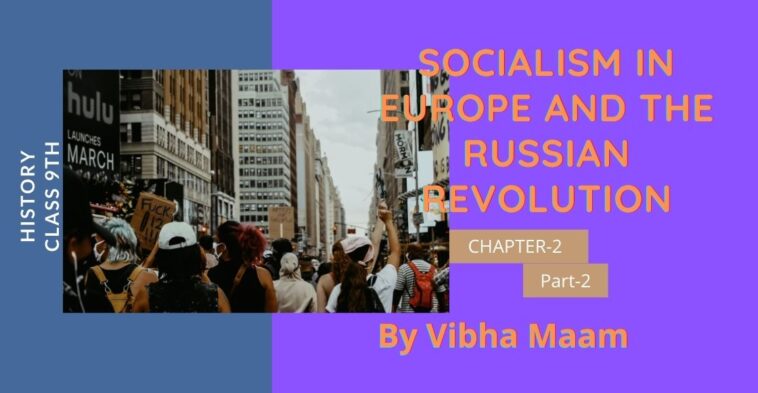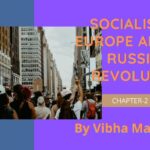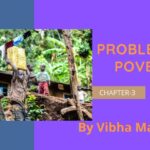Checkout handpicked notes of NCERT class 9th History Chapter 2 Socialism in Europe and the Russian Revolution Part 2 notes by Vibha Madam and don’t forget to share your valuable comments in the comment below to motivate our author.
Socialism in Europe and the Russian Revolution Part 2 Notes
The February revolution in petrograd
- In the winter of 1917, conditions of the capital, Petrograd were grim. There were food shortages in worker quarters due to bad harvests.
- On 22 February, a lockout took place at a factory on the right Bank. The next day, workers in fifty factories called a strike in sympathy .In many factories, women led the way to strike. That’s why this day came to be known as ‘International Women’s day’ .
- On Sunday 25th February, the government suspended the Duma.
- Demonstrators ransacked the police headquarters and raised slogans about bread, wages, better working conditions and democracy.
- Soldiers and striking workers had gathered to form ‘Soviet’ or ‘Council’. this was the Petrograd Soviet.
- On 2nd March, the Tsar abdicated .Soviet leaders and Duma leaders formed the Provisional Government to run the country .
- Petrograde had led the February Revolution that brought down the monarchy in February 1917.
After February
- The Provisional Government was controlled by landlords, industrialists, and army officials. so Lenin was against the provisional government.
- He declared that the war be brought to a close, land be transferred to the peasants, and banks be nationalised. These three demands were “Lenin’s April Theses”. The Bolshevik party was renamed the Russian communist Party .
- Bolsheviks were supported by Soviet, army and factory workers. many soviets were set up everywhere.
- In June, about 500 Soviets sent representatives to an All Russian Congress of Soviets.
- As the Provisional Government saw its power reduce and Bolsheviks influence grow, it decided to take stern measures:-
i) Government began arresting leaders of Soviets,
ii) Popular demonstrations staged by the Bolsheviks in July 1917 were sternly repressed,
iii) The army was used to attack the demonstrators.
iv) Meanwhile in the countryside, Socialist Revolutionary, Peasants seized land between July and September 1917.
The Revolution of October 1917
- It was led by the petrograd Soviet and the Bolshevik party under the leadership of Lenin
- A Military Revolutionary Committee was appointed by the Soviet under Leon Trotskii to organise the seizure.
- The uprising began on 24th October. Though Prime Minister Kerenskii resisted but the seizure was completed within a day.
Changes after October
- The Bolsheviks were totally opposed to private property.
- Industry and banking were nationalised in November 1917.
- land was declared social property .
- Bolshevik was renamed the Russian communist Party (Bolshevik).
- In November 1917, the Bolsheviks conducted the election to the constituent assembly but they failed to gain majority support .
- In January 1918, the Assembly rejected Bolshevik measures and Lenin dismissed the Assembly.
- In the years that followed, Bolsheviks took full control over the government and Russia became a single-party state.
The Civil War
When Bolshevik ordered land redistribution, the Russian army began to break up. the non-socialist liberals and supporters of autocracy condemned the Bolshevik (the Red) uprising.
The Green and White were the group of people who were against the Bolshevik Revolution and they started the Civil War. They were supported by the French, American ,British and the Japanese troops as these countries were worried about the growth of socialism in Russia.
Stalinism and Collectivisation
Stalin headed the Communist party of Russia after the death of Lenin. he introduced the collectivisation policy. Under this policy Kulaks(rich farmers of Russia) were eliminated and their land was taken away from them. it was converted into State- controlled large farms. This was introduced to increase production.
In spite of collectivisation, production did not increase immediately. In fact, the bad harvest of 1930-1933 led to one of the most devastating famines in Soviet history when over 4 millions died.
Don’t forget to comment in the comment section below to appreciate and motivate our author by sharing this notes with your friends you can also Contact us for any query or if you are interested in writing with us.
Use Canva for amazing images.
Stay tuned for more amazing stories, poems & articles like this.
For sponsor any article or your article you can mail us with your logo ready and details.










Thankyou mam for excellent notes
The global influence of Russia revolution and the USSR